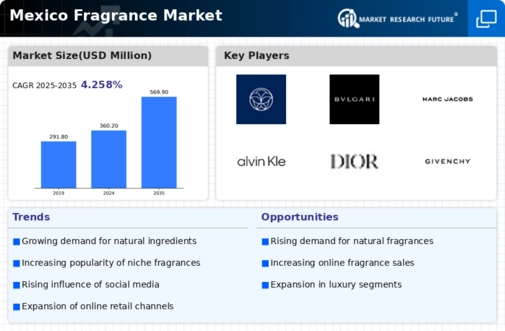The fragrance market in Mexico exhibits a dynamic competitive landscape, characterized by a blend of established global players and emerging local brands. Key growth drivers include increasing consumer demand for premium and niche fragrances, alongside a growing trend towards personalization in scent offerings. Major companies such as L'Oreal (FR), Estée Lauder (US), and Coty (US) are strategically positioned to leverage these trends. L'Oreal (FR) focuses on innovation and sustainability, emphasizing eco-friendly packaging and natural ingredients, which resonates with the environmentally conscious consumer base. Estée Lauder (US) has been enhancing its digital presence, utilizing e-commerce platforms to reach a broader audience, while Coty (US) is actively pursuing partnerships with influencers to enhance brand visibility and engagement. Collectively, these strategies contribute to a competitive environment that is increasingly driven by consumer preferences for quality and sustainability.
In terms of business tactics, companies are localizing manufacturing to reduce costs and improve supply chain efficiency. This approach not only enhances responsiveness to market demands but also aligns with the growing trend of supporting local economies. The market structure appears moderately fragmented, with a mix of large multinational corporations and smaller niche players. The influence of key players is significant, as they set trends and standards that smaller brands often follow, thereby shaping the overall market dynamics.
In October 2025, L'Oreal (FR) announced a new initiative aimed at reducing its carbon footprint by 50% across its fragrance production lines by 2030. This move underscores the company's commitment to sustainability and positions it favorably among eco-conscious consumers. By investing in renewable energy sources and optimizing production processes, L'Oreal (FR) not only enhances its brand image but also potentially reduces operational costs in the long run.
In September 2025, Estée Lauder (US) launched a new digital marketing campaign that integrates augmented reality (AR) technology, allowing consumers to virtually experience fragrances before purchase. This innovative approach not only enhances customer engagement but also reflects the company's commitment to leveraging technology in enhancing the shopping experience. Such initiatives may lead to increased sales and customer loyalty, as consumers are drawn to interactive and personalized shopping experiences.
In August 2025, Coty (US) entered into a strategic partnership with a leading social media platform to create exclusive content and limited-edition fragrance lines. This collaboration aims to tap into the growing influence of social media on consumer purchasing decisions. By aligning with popular influencers and creating buzz around new product launches, Coty (US) is likely to enhance its market presence and attract a younger demographic, which is crucial for long-term growth.
As of November 2025, current competitive trends in the fragrance market include a pronounced shift towards digitalization, sustainability, and the integration of artificial intelligence (AI) in product development and marketing strategies. Strategic alliances are increasingly shaping the landscape, enabling companies to pool resources and expertise to innovate more effectively. Looking ahead, competitive differentiation is expected to evolve, with a notable shift from price-based competition to a focus on innovation, technology, and supply chain reliability. Companies that can effectively harness these trends are likely to secure a competitive edge in the ever-evolving fragrance market.






















Leave a Comment